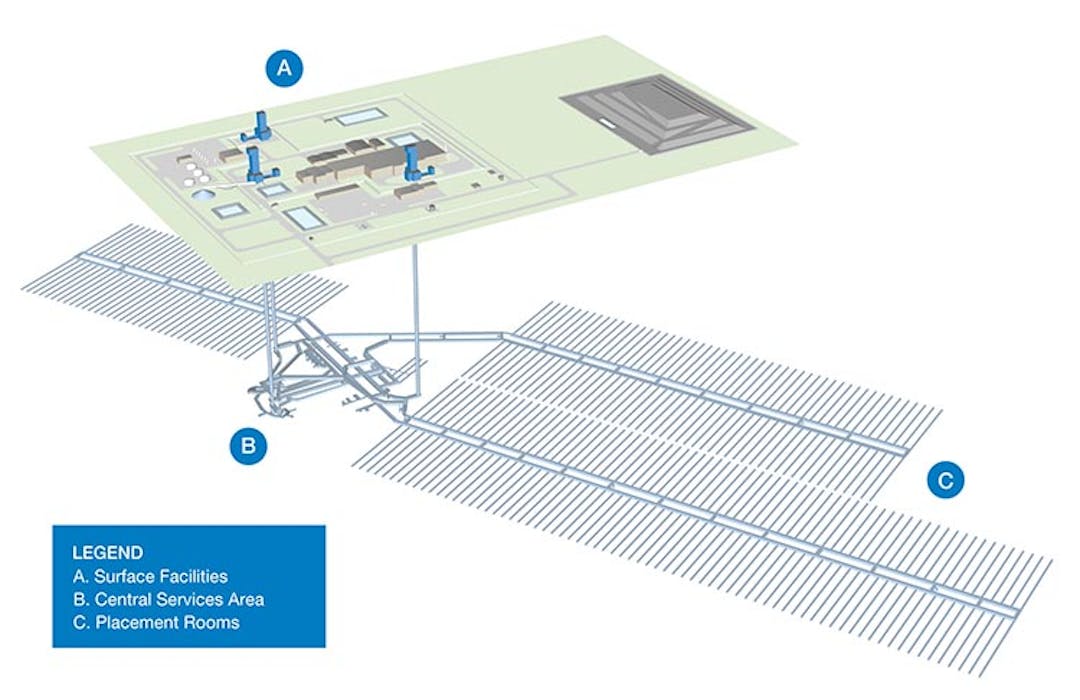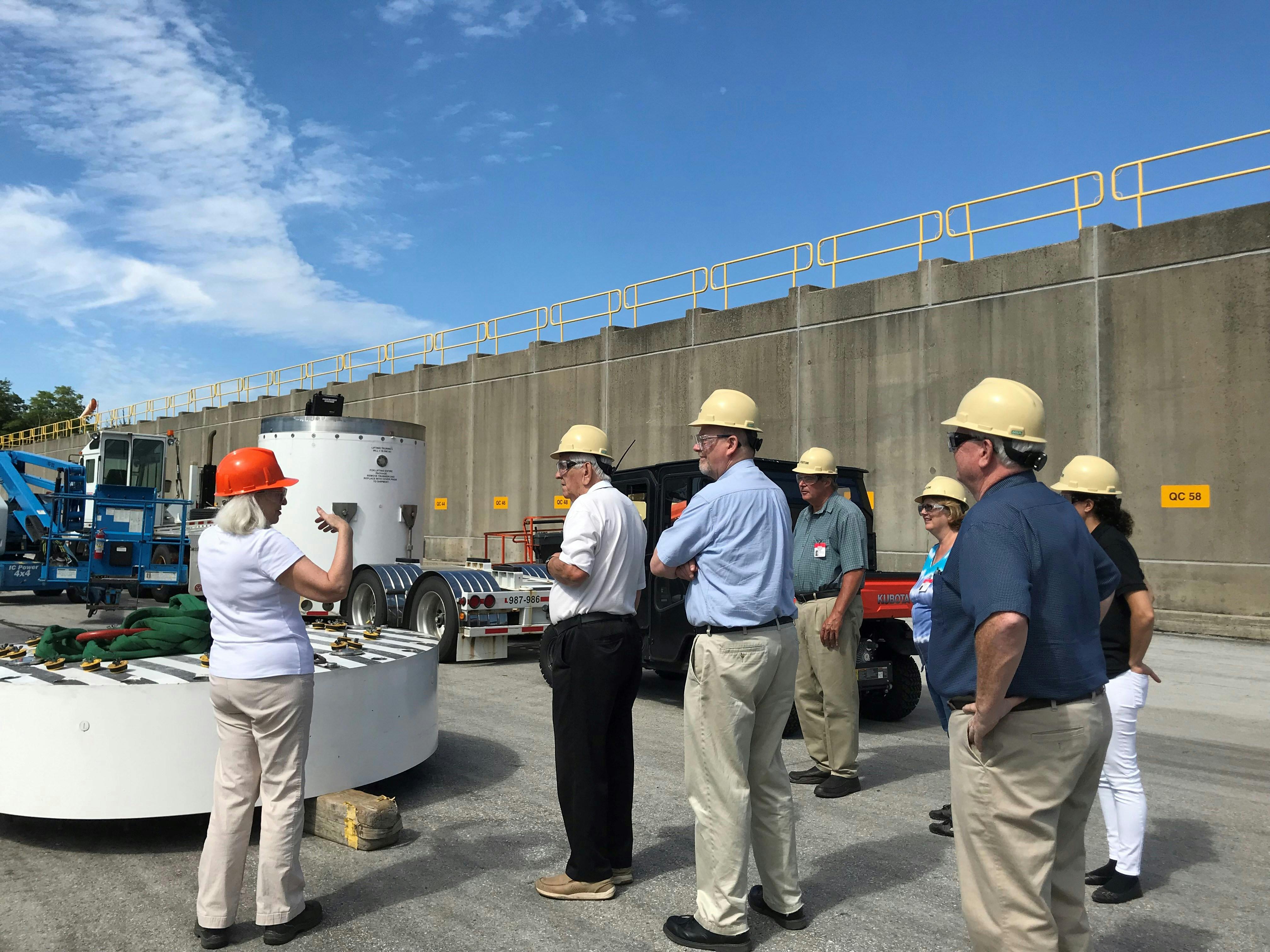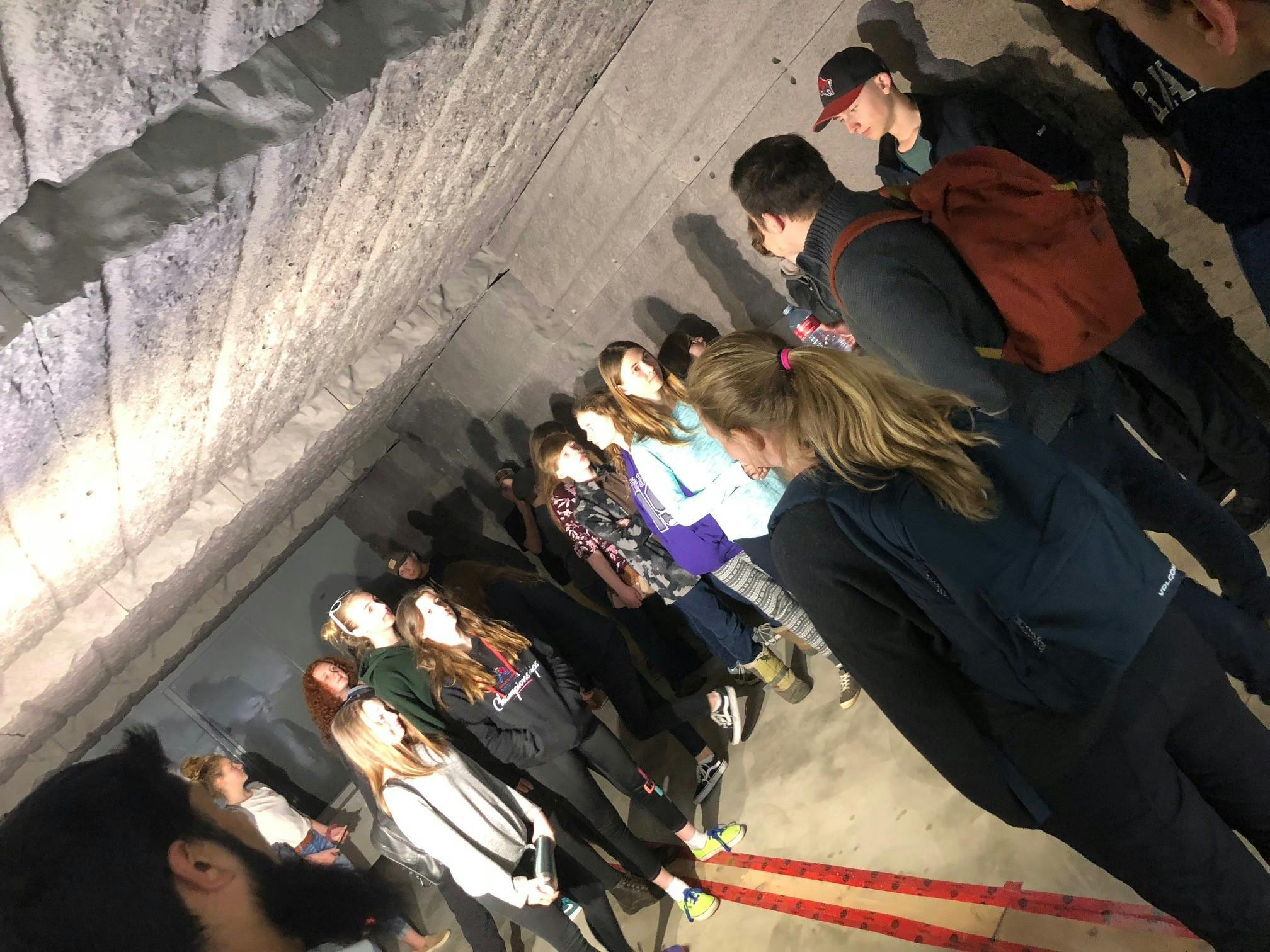Canada's Long-Term Plan for Used Nuclear Fuel
Consultation has concluded

Canada's plan for the safe, long-term management of used nuclear fuel requires that all of Canada’s used nuclear fuel be safely and securely isolated from people and the environment in a deep geological repository (DGR). The Nuclear Waste Management Organization (NWMO) is responsible for implementing this national infrastructure project estimated to cost $24 billion. This plan is also known as the Adaptive Phased Management Project.
The DGR is a network of underground tunnels and placement rooms for used nuclear fuel containers. It is designed to safely contain and isolate Canada's used nuclear fuel over the long term. A conceptual layout for a repository would require an underground footprint of about two kilometres by three kilometres (about 600 hectares or 1,500 acres).
The NWMO is expected to identify a single site by 2023. Once a site has been identified, additional technical studies will be required, and all regulatory requirements and approvals must be obtained through the Canadian Nuclear Safety Commission (CNSC).
The Township of Huron-Kinloss is no longer in the NWMO's site selection process. On January 24, 2020 the NWMO announced they had signed land agreements with residents in South Bruce that would allow sufficient access to land for studies at a potential deep geological repository location. This means the Township of Huron-Kinloss is no longer being considered as a potential host community for the proposed deep geological repository.
Two communities remain in the Site Selection Process including the Municipality of South Bruce and the Municipality of Ignace in Northern Ontario.
For more details, please see the NWMO Press Release.
Canada's plan for the safe, long-term management of used nuclear fuel requires that all of Canada’s used nuclear fuel be safely and securely isolated from people and the environment in a deep geological repository (DGR). The Nuclear Waste Management Organization (NWMO) is responsible for implementing this national infrastructure project estimated to cost $24 billion. This plan is also known as the Adaptive Phased Management Project.
The DGR is a network of underground tunnels and placement rooms for used nuclear fuel containers. It is designed to safely contain and isolate Canada's used nuclear fuel over the long term. A conceptual layout for a repository would require an underground footprint of about two kilometres by three kilometres (about 600 hectares or 1,500 acres).
The NWMO is expected to identify a single site by 2023. Once a site has been identified, additional technical studies will be required, and all regulatory requirements and approvals must be obtained through the Canadian Nuclear Safety Commission (CNSC).
The Township of Huron-Kinloss is no longer in the NWMO's site selection process. On January 24, 2020 the NWMO announced they had signed land agreements with residents in South Bruce that would allow sufficient access to land for studies at a potential deep geological repository location. This means the Township of Huron-Kinloss is no longer being considered as a potential host community for the proposed deep geological repository.
Two communities remain in the Site Selection Process including the Municipality of South Bruce and the Municipality of Ignace in Northern Ontario.
For more details, please see the NWMO Press Release.
-
Huron-Kinloss No Longer in the NWMO Site-Selection Process
Share on Facebook Share on Twitter Share on Linkedin Email this linkOn January 24, 2020, the NWMO announced they had signed agreements with landowners in South Bruce, Ont., that will allow sufficient access to land for studies at a potential deep geological repository location. This means the Township of Huron-Kinloss is no longer in the site-selection process and is not being considered as a potential host community for the proposed deep geological repository.
For more details, please visit the NWMO Press Release.
-
Skilled Trades Simulators visits Ripley-Huron Community School
Share on Facebook Share on Twitter Share on Linkedin Email this linkGrades 7 and 8 students at Ripley-Huron Community School got a first-hand look at the new Skills Opportunities Showcase (SOS) Trailer 2.0 that officially launched on Friday, Dec. 6. The SOS Trailer 2.0 aims to give youth in schools across Bruce and Grey counties exposure to the skilled trades and science, technology, engineering, and mathematics (STEM) fields.
The SOS Trailer 2.0 is the first-of-its-kind in Ontario and will showcase various skilled trade opportunities including tire changing, heavy equipment, hair styling, welding, carpentry, culinary, masonry, electrical wiring, as well as various STEM learning tools and dexterity challenges.
The SOS Trailer 2.0 will visit schools across Bluewater District School Board and Bruce-Grey Catholic District School Board. The initiative is expected to reach more than 20,000 students in the area’s 50 elementary schools and 11 secondary schools.
It was funded through the collaborative efforts of the Township of Huron-Kinloss and the Municipality of South Bruce that each provided $12,500. In addition, the Nuclear Waste Management Organization (NWMO) contributed $50,000 through its Early Investment in Education and Skills (EIES) program. The EIES program supports education and skills training for residents of areas actively participating in Canada’s plan as a way to contribute to community well-being and capacity. The SOS Trailer 2.0 was purchased by the Four County Labour Market Planning Board.
-
Update on NWMO site selection process
Share on Facebook Share on Twitter Share on Linkedin Email this linkTORONTO, Ont., Nov. 26, 2019 – The Nuclear Waste Management Organization (NWMO) is advancingthe site selection process for a deep geological repository for Canada’s used nuclear fuel. The organization will narrow its focus from five to two potential siting areas. This an important advancement in Canada’s plan.Please view the News Release for more details on the recent announcement.
-
Family Science Night
Share on Facebook Share on Twitter Share on Linkedin Email this linkThe Ripley-Huron Community Centre was full of eager learns - of all ages - during the Family Science Night on November 19. Over 150 parents and children showed up to see how to make elephant toothpaste, build soaring hoopster planes, flip-flopping tumble bunnies and a wide variety of pelts, skulls and specimens in the discovery centre.
The Family Science Night was funded by the Township of Huron-Kinloss' Early Investment in Education and Skills program, supported by the NWMO.
-
Huron-Kinloss Nuclear Waste Community Advisory Committee Meeting Schedule 2020
Share on Facebook Share on Twitter Share on Linkedin Email this linkThe Nuclear Waste Community Advisory Committee (NWCAC) work with the Nuclear Waste Management Organization (NWMO) and the community of Huron-Kinloss in the in the process of gathering information regarding the possibility of siting a high-level nuclear waste Deep Geologic Repository (DGR) in Huron-Kinloss.
Each month from February to November the NWCAC meets to hear from series of scientists, experts, regulators and NWMO staff about nuclear energy and Canada's plan for the safe, long-term management of used nuclear fuel. These meetings are held in the Township of Huron-Kinloss Council Chambers, beginning at 7pm.
Meeting notices are mailed to each Huron-Kinloss resident and property owner a few weeks prior to each meeting, providing more details about the presentation.
Nuclear Waste Community Advisory Committee 2020 Meeting Schedule
January 2020 - No MeetingFebruary 4, 2020March 3, 2020April 7, 2020May 5, 2020June 2, 2020July 7, 2020August 4, 2020September 1, 2020October 6, 2020November 3, 2020December 2020 - No Meeting
-
Committee hears from Finnish company about the world's first DGR for used nuclear fuel
Share on Facebook Share on Twitter Share on Linkedin Email this linkHuron Kinloss and South Bruce recently welcomed Mika Pohjonen from Posiva to share Finland’s journey from approval to construction of the worlds’ first deep geological repository (DGR) for spent nuclear fuel.
Posiva is the Finnish counterpart to the NWMO. They are also responsible for the safe, final disposal of used nuclear fuel in a manner that protects people and the environment.
Posiva's program was initiated 40 years ago, beginning their process in 1978. After a 17-year site selection process, Olkiluoto Island, which is about 220 kilometres northwest of Helsinki, was chosen to host the DGR for used nuclear fuel from Posiva's two owner utilities. Posiva was granted the first construction licence in the world for a DGR in 2015 and began construction shortly thereafter in 2016.
“Posiva is now in full speed construction of the encapsulation plant and first final disposal tunnel,” said Mr. Phjonen. “We are planning to submit the operating license application in 2021 and begin operation in 2025.”
“Having Mr. Pohjonen visit the CLCs in South Bruce and Huron-Kinloss provides a valuable opportunity for information and knowledge sharing,” said Paul Austin, Relationship Manager at the NWMO. “As the communities continue to explore Canada’s Plan for used nuclear fuel, having experts from other countries share their experience gives the NWMO and our communities the opportunity to learn from other countries.”
Mr. Pohjonen also toured Ontario Power Generation’s (OPG) rock core storage facility and learned about the rock in Bruce County and OPG’s plans for a DGR for low and intermediate level waste. Finland’s two final disposal repositories for low and intermediate level waste have been in operation for over 20 years.
The NWMO is currently collaborating with Posiva on a large-scale research project – Full-Scale In-Situ System Test – that will inform nuclear waste management efforts around the world. The NWMO works with specialists from Posiva and others around the world to ensure Canada’s plan continues to be based on and benefit from the best science.
To get more information of Posiva's project, see www.posiva.fi or search for "Posiva final disposal" in Youtube.
-
Successful 2019 Huron-Kinloss Nuclear Waste Management Symposium
Share on Facebook Share on Twitter Share on Linkedin Email this linkThe 2019 Huron-Kinloss Nuclear Waste Management Symposium was a great success, with over 50 residents spending the morning learning more about Canada's plan for the safe-long term management of used nuclear fuel.
The Symposium focused
on four key topics of the project which included: Geology in Huron-Kinloss, Transportation of Used Nuclear Fuel; Safety of the Deep Geological Repository; the Land Access Process in Huron-Kinloss. These presentations can be found on the Township of Huron-Kinloss website. -
Huron-Kinloss Nuclear Waste Community Advisory Committee Meeting
Share on Facebook Share on Twitter Share on Linkedin Email this linkJoin us on Tuesday, October 1 for the Nuclear Waste Community Advisory Committee meeting beginning at 7pm in Council Chambers, located at 21 Queen St., Ripley.
The Committee is looking forward to hearing from Professor Josh D. Neufeld is a Microbial Ecologist in the Department of Biology at the University of Waterloo. He studies microbial diversity in order to understand how microbial communities interact with each other within aquatic, terrestrial, and host-associated environments.
-
NWMO specialist shares findings on long-term repository safety
Share on Facebook Share on Twitter Share on Linkedin Email this link
Canada’s plan for the safe, long-term management of used nuclear fuel calls for used fuel to be contained and isolated in a deep geological repository, in an area with informed and willing hosts. Understanding how a deep geological repository will respond over extended periods of time is key to our work and involves the publication of a series of case studies focused on long-term repository performance.
Dr. Erik Kremer, Section Manager of Siting Safety Assessment at the Nuclear Waste Management Organization (NWMO), recently shared findings from the Seventh Case Study: Postclosure Safety Assessment of a Used Fuel Repository in Sedimentary Rock, at the July meetings of the Nuclear Waste Committees in Huron-Kinloss and South Bruce.
“The Seventh Case Study illustrates how repository safety is assessed over the very long term. The case study considers normal evolution and disruptive scenarios, and concludes that a repository could be safely sited in the sedimentary rock formations found in southern Ontario,” said Dr. Kremer, whose day-to-day work focuses on the long-term safety of a deep geological repository.
These reports build on a series of postclosure safety assessments illustrating the long-term performance and safety of different repository designs within various geological settings. The Seventh Case Study builds on existing work, including the Sixth Case Study focused on crystalline rock.
“Gaining a better understanding of safety, particularly as it relates to the geology in our area, is really important for those of us actively engaged in learning about the project,” said David Grant, member of the Huron-Kinloss Nuclear Waste Community Advisory Committee. “It was great to have members of the community attend and ask questions of Dr. Kremer – this helps further local understanding of the project.”
Postclosure safety assessments help build confidence in the long-term performance of a deep geological repository for Canada’s used nuclear fuel.
“A deep geological repository must be able to safely isolate used nuclear fuel over very long periods of time. These case studies help us to understand and illustrate the long-term safety of a repository,” added Dr. Kremer. “They also provide a platform for discussion with our siting communities, their regional partners, the regulatory authorities, and other experts in the field, as well as with repository programs all around the world.”
The NWMO collaborates with organizations in Canada and around the world to bring their expertise together and remain consistent with international best practice. Ultimately, the safety case will be subject to peer review, both national and international, and an independent regulatory review by the Canadian Nuclear Safety Commission (CNSC).
The NWMO is on track to identify a single, preferred site for a deep geological repository by 2023, in an area with informed and willing hosts. When the NWMO applies for a licence, the application to the CNSC will include a safety case, which will include results of site-specific geoscience investigations, a site-specific repository design, and a comprehensive safety assessment.
No licence will be granted until the NWMO can demonstrate that the health and safety of the public, the workers, and the environment are protected.

-
Huron-Kinloss and NWMO Land Access Process
Share on Facebook Share on Twitter Share on Linkedin Email this linkThe next step for Huron-Kinloss in the site selection process is the Land Access Process. The NWMO is asking landowners to sign option agreements to access sufficient land for a potential repository site.
Optioning the land will provide the NWMO with two important assurances: the knowledge it could acquire sufficient land for the repository in the future and the ability to complete its site investigation work.
The NWMO is committed to protecting farmland and minimizing disruption to local businesses. The NWMO will only need to access small areas of the optioned lands to conduct its studies and we expect most, if not all, of the ongoing operations will be able to continue.
There are currently five potential siting areas engaged in the site selection process – no site has been selected.
Photos
Life Cycle
-
The Beginning
Canada's Long-Term Plan for Used Nuclear Fuel has finished this stageThe NWMO was created by Canada’s nuclear energy generators (Ontario Power Generation, New Brunswick Power and Hydro-Québec) in 2002 as a requirement of the Nuclear Fuel Waste Act. The Act requires the NWMO to study possible approaches, recommend and then implement a plan for the long-term management of used nuclear fuel in Canada.
-
Canada's Plan
Canada's Long-Term Plan for Used Nuclear Fuel has finished this stageIn June 2007, the Government of Canada selected Adaptive Phased Management (APM), as Canada’s plan for the long-term management of used nuclear fuel. The NWMO is now responsible for implementing this plan.
-
Site Selection Process Begins
Canada's Long-Term Plan for Used Nuclear Fuel has finished this stageNWMO initiated the siting process in 2010 with a broad program to provide information, answer questions and build awareness. Awareness-building activities are designed to continue throughout the site selection process.
-
The Township of Huron-Kinloss Enters Site-Selection Process
Canada's Long-Term Plan for Used Nuclear Fuel has finished this stageIn April 2012, the Township of Huron-Kinloss voluntarily entered the site selection process. Based on studies to date, the community appeared to have strong potential for meeting strict safety and geotechnical requirements and for the project to align with its long term vision.
-
Huron-Kinloss Nuclear Waste Community Advisory Committee Appointed
Canada's Long-Term Plan for Used Nuclear Fuel has finished this stageOn May 22, 2013 Huron-Kinloss Council appointed the members of the Nuclear Waste Community Advisory Committee. The committee members were selected by an open process. The NWCAC meet on a monthly basis.
-
Narrowing the Site Selection
Canada's Long-Term Plan for Used Nuclear Fuel has finished this stageIn 2018, NWMO narrowed down the site-selection process to 5 communities, from the original 22. Communities still remaining in the site selection process are Huron-Kinloss and South Bruce as well as three northern Ontario communities of Manitouwadge, Hornepayne and Ignace.
-
2019-2023
Canada's Long-Term Plan for Used Nuclear Fuel is currently at this stageThe current phase of work involves more intensive community learning and engagement. The Township is working with the NWMO to initiate community well-being studies, broaden engagement and work with Indigenous and Métis communities in the area.
The next step for Huron-Kinloss is the Land Access Process. The NWMO is asking landowners to sign option agreements to access sufficient land in order to begin site characterization work including borehole drilling and environmental baseline monitoring.
-
Site Selected in 2023
this is an upcoming stage for Canada's Long-Term Plan for Used Nuclear FuelThe NWMO is expected to identify a single site by 2023. Once a site has been identified, additional technical studies will be required, and all regulatory requirements and approvals must be obtained through the Canadian Nuclear Safety Commission (CNSC).
-
Looking Forward
this is an upcoming stage for Canada's Long-Term Plan for Used Nuclear FuelBy 2024, the NWMO will begin details for the Site Characterization and construction of the Centre of Expertise.
-
2028-2033
this is an upcoming stage for Canada's Long-Term Plan for Used Nuclear FuelThrough the Regulatory Approval process, the NWMO hopes to have the Environmental Assessment and Construction License granted.
-
2033-2044
this is an upcoming stage for Canada's Long-Term Plan for Used Nuclear FuelDesign and construction started and operations begin.







